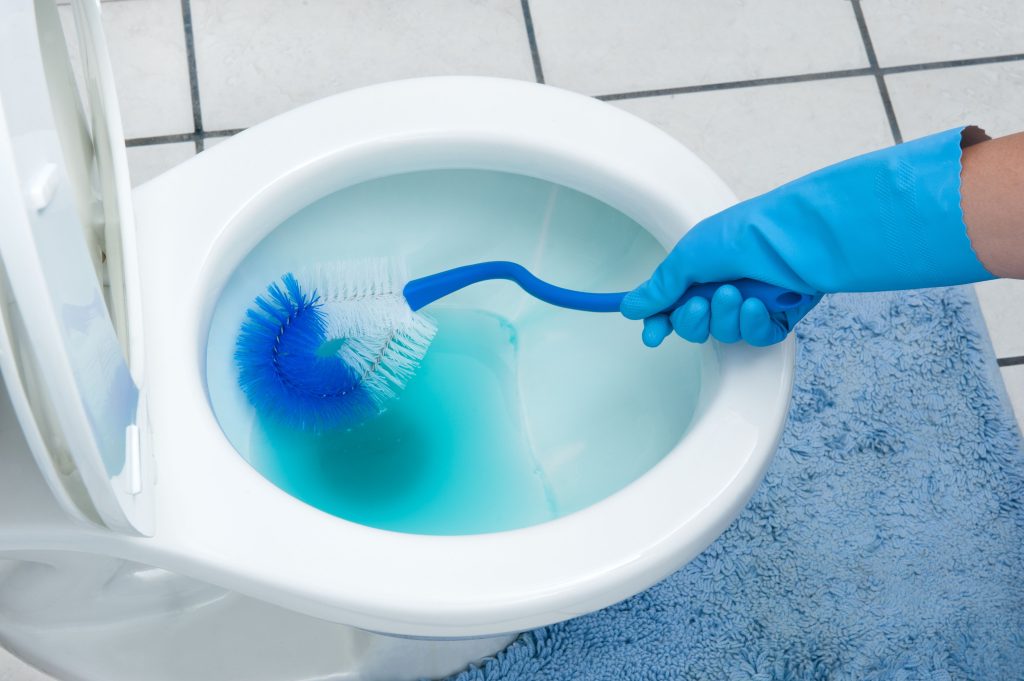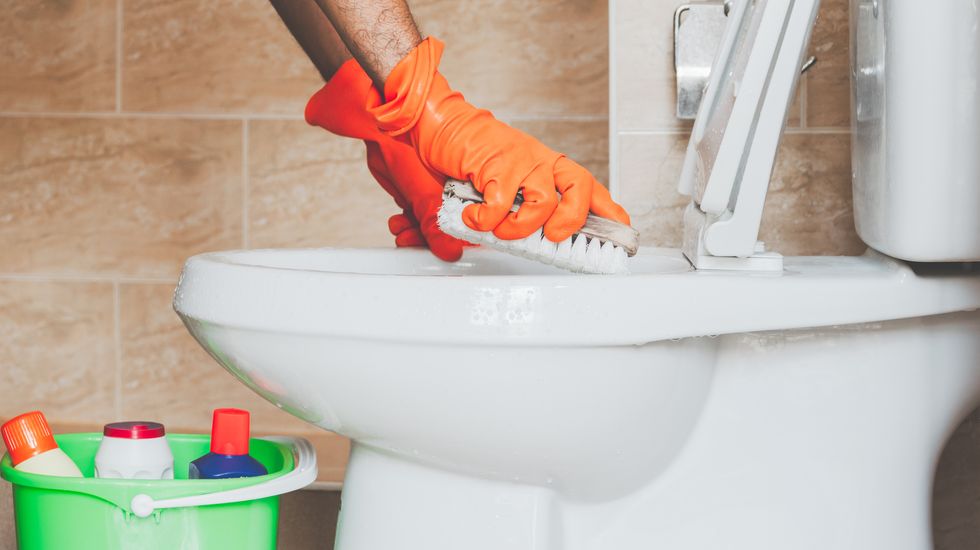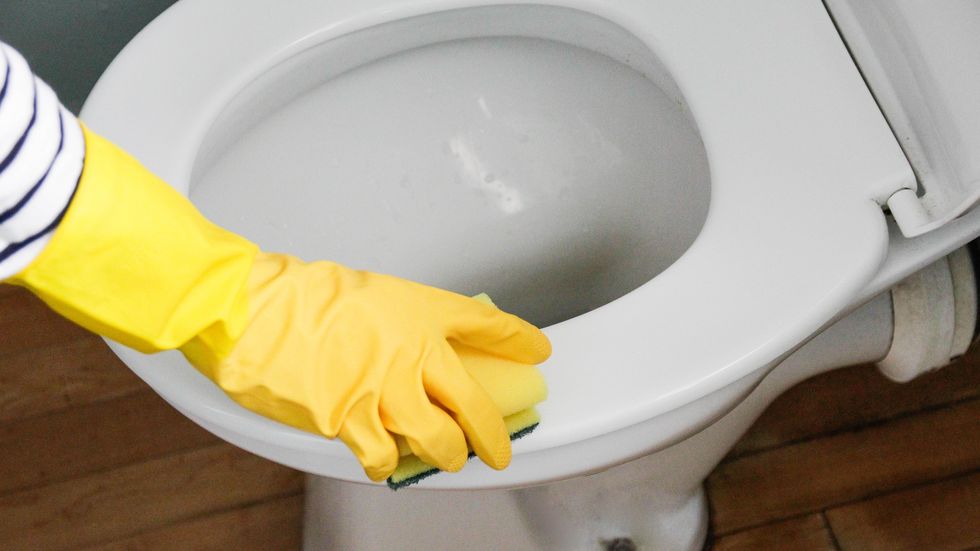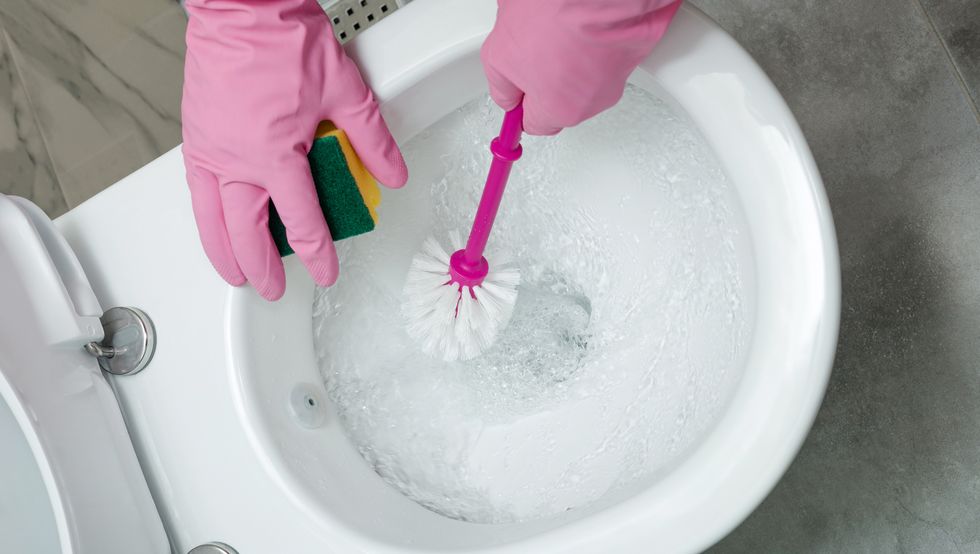Cleaning the toilet might not be your favorite thing to do when it comes to refreshing the bathroom, but it’s necessary. As time goes on, and even after its first use, your toilet can start to accumulate high amounts of mold, yeast and germs. That’s why it’s important to know the best toilet bowl cleaning tips and products to rid every part of your toilet —including the lid, exterior and tank — of viruses and germs.
When cleaning your toilet, figure out what products will work best. According to Carolyn Forté, the executive director of the Good Housekeeping Institute Home Care & Cleaning Lab, many people neglect to read the instructions on their cleaning products. “Yes, a product can claim that it kills 99% of germs and bacteria,” she says. “But it needs to stay wet to be effective, and if you’re using it for a matter of seconds, it’s not going to be effective.” What’s more, Charles Gerba, Ph.D., a professor of epidemiology and biostatistics in the Department of Environmental Science at the University of Arizona, found that viruses, in general, can live on your toilet’s surface anywhere from a few hours to a few days. “Most cold and flu viruses survive from a few hours to up to nine days, [depending] on temperature and relative humidity,” he says. This only adds to your toilet’s icky factor and the consistent need to clean it throughout the week.
So, follow our step-by-step guide below to learn how to properly clean your toilet. We even share our favorite (and expert-approved bathroom cleaners) and DIY solutions to keep your toilet sparkly clean on a regular basis.
What You Need to Clean Your Toilet
Before you get started, you’ll need to be well-equipped for the job. Forté recommends keeping a separate set of cleaning tools that aren’t used on other surfaces across the home. Despite there being a multitude of bathroom cleaners homeowners can use, she recommends the following list of supplies.
How to Clean Your Toilet the Right Way
Cleaning the Toilet Bowl:
When you clean your toilet, start with the bowl first. Forté says to give the cleaner time to work while you tackle the remaining bowl surfaces. Choose products that are formulated to clean and disinfect the toilet bowl, like Clorox Toilet Bowl Cleaner with Bleach, as it disinfects the inside of the toilet in just five minutes. Coat the entire toilet bowl interior, starting underneath the bowl’s rim. Put on your gloves and use your toilet brush to scrub away stains and deposits. “Be sure to scrub well with the cleaner around the inside of your bowl, the toilet bend if possible and underneath the rim of the bowl,” Forté explains. “Then, you’ll want to let everything sit for five minutes before flushing it away.”
If you run out of toilet bowl cleaner, the next best thing is actual bleach itself, Forté says. Simply measure out half a cup’s worth of bleach and pour it into your toilet bowl. Use your toilet brush to scrub the sides and beneath the bowl’s rim, also allowing five minutes to pass before you flush it all away.
Cleaning the Outside of the Toilet:
To clean the outside of the toilet, Forté recommends an all-purpose bathroom disinfecting spray, like Lysol Power Bathroom Foamer. It sanitizes hard surfaces in 30 seconds and disinfects them in 10 minutes. Tackling one area at a time, clean the tank, outside of the bowl and the sides. Spray the cleaner, wipe each area thoroughly with your sponge or cloth, then rinse well before moving on to the next area, Forté says. Don’t forget to clean the small area between the toilet seat and the tank.
And remember, surfaces need pre-cleaning before they can be disinfected and need to stay wet for the recommended time on the label to effectively kill germs. If you don’t want to leave the cleaner on for as long as recommended to disinfect — 10 minutes in some cases — after the toilet is clean and dry, go over all the surfaces again with a disinfecting wipe or apply a disinfecting spray, like GH Seal star Microban 24 Hour Sanitizing Spray, making sure they stay wet for the required time to kill bacteria and viruses.
Cleaning the Toilet Seat:
Use the bathroom cleaner to clean both sides of the lid and toilet seat thoroughly as you did with the tank and outer surfaces. Lower the seat back on top of the bowl once you’ve finished.
Give the toilet flush handle — a high-touch spot — an extra pass with a disinfecting wipe and allow it to air dry. In between cleaning sessions, it’s also a good idea to use a disinfectant wipe to rub the handle down before allowing it to air dry. Finally, don’t forget to flush your toilet if you haven’t already!
How Do I Clean My Toilet With Vinegar and Baking Soda?
Give your toilet a simple yet effective refresh using a white vinegar and baking soda mixture. According to Forté, vinegar is best for removing hard water stains. First, drain the water out of your toilet bowl. Pour enough cups of white vinegar into the bowl, making sure it reaches and covers the entire rim and the water line, “so the vinegar dissolves the minerals that build up there,” Forté notes. Close the seat and let the vinegar sit overnight. Then, pour one cup of baking soda into the bowl and add more vinegar, if needed, to create a fizzier solution. Throw on a pair of gloves before you start scrubbing inside the bowl. When done, flush and repeat the process, if needed, until the stains are gone.
You can also quickly clean the toilet bowl without scrubbing by simply stirring the solution with your toilet brush. Some stains and dirt deposits will begin breaking down from the vinegar and baking soda solution. Flush to rinse everything out.
How Often Should I Clean My Toilet?
Disinfecting your toilet can help reduce the risk of coming into contact with threatening germs in your home. But it’s important to understand that even after just one use, the toilet could once again play host to bacteria and viruses on its surfaces.
Forté says you should try to clean your toilet as often as possible, but that you should fully disinfect it every two to three days if someone is sick in your home. Outside of flu season, once a week — or biweekly, depending on how frequently the toilet is used — should suffice.
Forté also recommends factoring in time to actually disinfect your cleaning supplies. A toilet scrubbing brush can grow mold on its own if it’s left in a watery holder. Forté says you should periodically clean it after you’ve finished scrubbing the toilet bowl and surfaces. Spray it thoroughly with a disinfectant spray, and let it air dry by placing it between your toilet seat and the bowl itself (allowing the scrubbing head to hang above the water in the bowl). For your gloves, sponges or any other plastic cleaning supplies, you can make sure they’re germ-free by soaking them for five minutes in a solution of three tablespoons of bleach mixed in one quart of water. Air-dry afterward.
Health Editor
Zee Krstic is a health editor for Good Housekeeping, where he covers health and nutrition news, decodes diet and fitness trends and reviews the best products in the wellness aisle. Prior to joining GH in 2019, Zee fostered a nutrition background as an editor at Cooking Light and is continually developing his grasp of holistic health through collaboration with leading academic experts and clinical care providers. He has written about food and dining for Time, among other publications.
Assistant Editor
Mariah Thomas (she/her) is an assistant editor for Good Housekeeping, where she covers home and lifestyle content. Mariah has more than four years of editorial experience, having written for TLC, Apartment Therapy, Women’s Health and Avocado Magazine. She received her master’s degree in journalism at the Craig Newmark Graduate School of Journalism and published her first book, Heart and Soul: Poems of Thoughts and Emotions, in 2019. She’s also the founder of RTF Community a platform for creatives of color to connect, learn and showcase their work.
Read the full article here


















